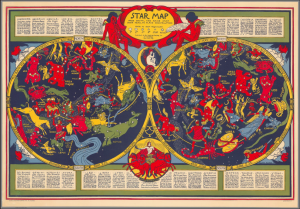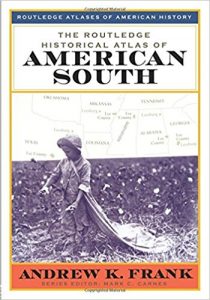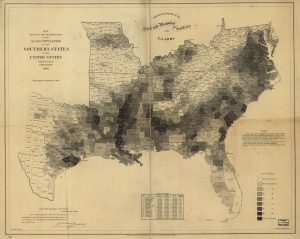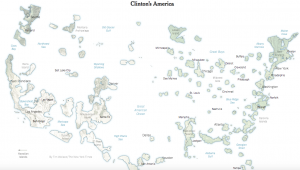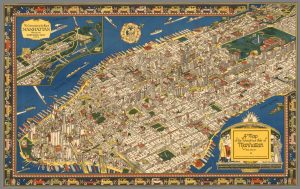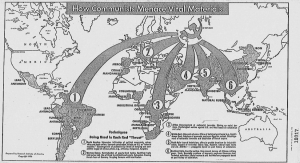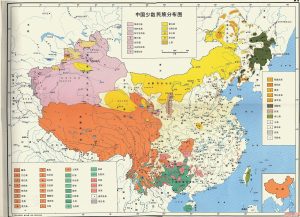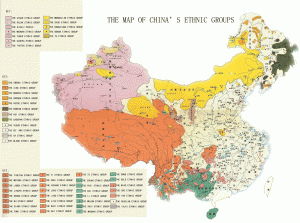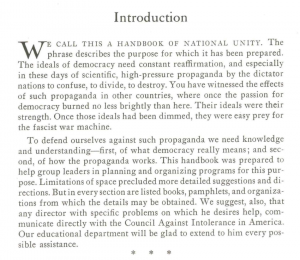October 29, 1929 was one of the greatest shocks to hit the United States. Starting on a day known as “Black Thursday,” on October 24th, stocks fell over 23 percent. The Country was sent into a frenzy as 9,000 banks closed over the following three years, dragging billions of dollars in deposits down with them. The massive loss sky rocketed unemployment to 25 percent leaving families without money to spare. In this devastating time people looked for anything to distract them from the struggles they faced daily. With low income, families had to find cheap means of entertainment. Board games became increasingly popular as did radio shows like Lone Ranger and Jack Benny. Even though money was tight people continued to go to movies and musicals as an escape from everyday life.[1]
Elizabeth Shurtleff is known for many different maps including maps of Massachusetts and Isles of Sholes, which are are fully embellished with cartouches on and around the map. similar to her other pictorial maps created in the 1930s, her “Star Map” is brightly colored map contrasted the harsh realities of everyday life. Looking at this map, it is very far from what many people think of when they think of maps. It doesn’t depict geography or land masses and doesn’t seem very scientific. This map instead depicts stars and constellations in a very user-friendly manner. On the top there are simple instructions to “Face south and raise map over head to place constellations” along with a brief key of what the different symbols for star types mean. This map is by no means extremely scientific or technical, but instead is an easy medium for entertainment at a very low cost.
Similar to other means of entertainment like movies and theater, astrology, in some ways, can transport a viewer to a different world, removing the present realities from their lives for a moment. The sky has always been a mysterious extraordinary part of life. There are still many questions that are left unanswered about the sky and stars, so it is a continuous point of exploration. Interest in the sky was documented as early as 3000 BCE, through the 1930s and even in present day. The Babylonians first recognized the Zodiac, or the sequence of constellations, that serve as a marking points of passage of time, then later in the 6th century BCE the Greeks gave the cycle of constellations links to Greek gods, leading to predictions on affairs of state based on the stars and eventually to casting fortunes like we know today as horoscopes[2]. After losing traction in popularity during the new age of enlightenment, Astrology began to come back into popularity in the early 20th century, with the help of Sepharial and Alan Leo who founded the Astrological Lodge of the Theosophical Society in Great Britain. Since their revolution western society’s fascination with astrology has continued to grow[3].
The map depicts the constellations in a brightly colored manner that looks more like a painting than an actual map. Instead of lines connecting the stars to show the constellations, images of the animal or figure that the constellation portrays surrounds the stars. The cartographer of this map chose to omit stars that are not part of the specific constellations leaving only a few for decoration. The map isn’t a scientific representation of the sky, but instead instructions for every-day individuals to identify constellations and look at the stars. The simplicity is very important because it can really be used by people of all ages and backgrounds, so the entertainment value of the map is available to everyone. Drawn in a similar manner to the constellations inside the actual map, there are also other images that surround it. One that especially stands out is at the bottom of the map. It is a depiction of Phoebus Apollo, or the sun god. He is depicted in his four-horse chariot in a yellow circle. This is in reference to the Greek myth that he used this chariot daily to move the sun across the sky. Above Apollo is Diana the moon goddess in an orb representing the moon in the sky. These gods and goddesses included on the map are fairly recognizable to most people. The relatability of the map, makes the users of the map see astrology as something that is assessable to everyone. Framing the outside of the map is a list of all the constellations, along with riddle like description of the constellation to aid in placing it. For example, Aquarius’s description is “The Water-Bearer pours water into Piscis Australis the southern fish under the House’s head. The Water-Bearer, next to Capricorn, stretches his right hand.” These riddles add another fun layer to the activities that can be done using the map because all the riddles are like puzzles that can be deciphered along with the main star gazing.
On the top of the map sits two childlike angels, one holding a telescope looking down at the stars and the other holding a book with the opening lines of “Twinkle, Twinkle little Star”. The inclusion of these figures reaffirms that this map is not only for the use of adults but really as an activity for children and their families because” Twinkle, Twinkle little star” is a well-known nursery rhyme. Shurtleff’s cartographic choices were very important to making the map really accessible to all walks of life.
In devastating times people looks for means of escape to remove them from the realities of their everyday lives. The sky is a point of fantasy and wonder, which makes it the perfect means of escape. Elizabeth Shurtleff’s “Star Map” combined a cheap form of entertainment that was vital during the Great Depression along with the wonder of the stars to create the perfect activity map for families to utilize in such a disheartening time.
[1] “WGBH American Experience. Riding the Rails.” PBS. Accessed March 24, 2017. http://www.pbs.org/wgbh/americanexperience/features/timeline/rails-timeline/.
History.com Staff. “The 1930s.” History.com. 2010. Accessed March 24, 2017. http://www.history.com/topics/1930s.
[2] “HISTORY OF ASTROLOGY.” HISTORY OF ASTROLOGY. Accessed March 24, 2017. http://www.historyworld.net/wrldhis/PlainTextHistories.asp?historyid=ac32.
[3] “Short History of Astrology in the Western World.” Short History of Astrology in the Western World. Accessed March 24, 2017. https://thezodiac.com/weird/history.htm.

